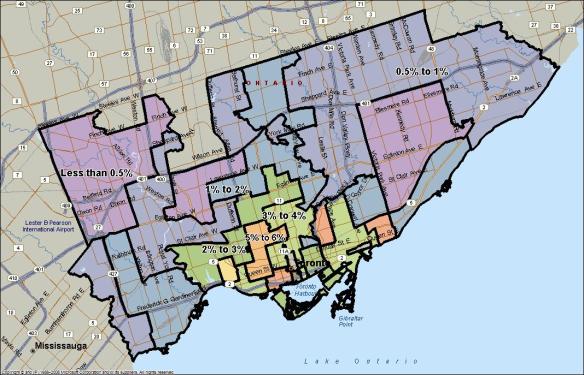According to new research, Toronto is home to 66% more artists than in any other city in Canada. The artists living in Toronto account for 16% of all artists in the country. Where can these artists be found? The recent Hill Strategies Inc. report, Mapping Artists and Cultural Workers in Canada’s Largest Cities, indicates that in Toronto, ‘most of the areas with highest concentration of artists are fairly centrally located’.
“…Strategies to encourage the arts should include the development and maintenance of neighbourhoods that are accessible and desirable for artists.”
The distribution of artistic neighbourhoods across the city is far from balanced. Of Toronto’s top ten neighbourhoods for artists and cultural workers, every single one is found south of St. Clair. Out of these top ten, ‘the top four neighbourhoods are all located west of Yonge Street’. The neighbourhoods that made the Canada-wide top ten are: Parkdale, West Queen West, M6G (College to St.Clair between Bathurst and Ossington), and M5R (the Annex and Yorkville).
“On an individual level, the arts can stimulate, inspire and entertain. At the neighbourhood level, strong artistic environments may contribute to changes in local economies, social environments, neighbourhood character and demographics.“
So, what are the implications for other Toronto neighbourhoods, particularly those north of St. Clair? As noted in the report, ‘cultural development in cities is partly an issue of neighbourhood development’. Most artists and cultural workers are already familiar with the significant role that they play in the development of home communities. In addition to maintaining the level of artists residing in downtown neighbourhoods, it is important to consider the development of other areas of Toronto. As Toronto continues to expand, how can we support the growth of artistic neighbourhoods in outlying areas?
“There is a large body of research that shows that the arts can contribute to the quality of life as well as the social and economic vitality of cities….In short, a strong artistic community anchored in strong local neighbourhoods can enhance the whole community’s well-being. For these reasons, it is important to identify and track creative neighbourhoods – areas that are attractive to artists for a number of reasons: inexpensive housing, access to employment and self-employment opportunities, access to resources (such as studio space, galleries, rehearsal and performance space, artist-run centres and associations), social networks, physical environment, family reasons and more.“
–
Skye Louis is currently serving as Coordinator of the Neighbourhood Arts Network.
Mapping Artists and Cultural Workers in Canada’s Largest Cities was jointly commissioned by the Cities of Vancouver, Calgary, Toronto, Ottawa, and Ville de Montreal and published in February 2010. The full report and summary are available free online from Hill Strategies Research Inc.

